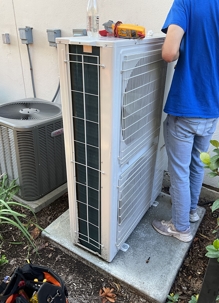As HVAC technology evolves, so do the standards for refrigerants that keep our homes cool and comfortable. Starting in 2025, major changes are coming that affect every homeowner with an older air conditioning system. Let’s break down what’s happening — and why replacing your entire system is no longer optional when it comes to new refrigerants.
1. Old Refrigerants: R22 and R410A
- R22 (Freon): Banned from production/import in the U.S. since 2020 due to its ozone-depleting effects.
- R410A (Puron): Still found in many homes, but being phased out beginning in 2025 due to its high Global Warming Potential (GWP).
If your current system runs on one of these refrigerants, its time is almost up.
2. New Refrigerants: R-454B and R-32
The next-generation refrigerants approved for new systems are here, and they’re designed for efficiency and safety under today’s environmental standards.
New Refrigerant | Used In | Benefits |
|---|---|---|
R-454B | Most new residential systems | Low GWP, mildly flammable (A2L) |
R-32 | Some ductless & split systems | High efficiency, lower GWP |
But here’s the catch: they are not compatible with older systems.
Why You Must Replace the Whole System
Not Backward Compatible – When new refrigerants are introduced, they aren’t simply “drop-in” replacements. Each refrigerant operates under different pressures and requires components designed to handle those specific conditions. For example, today’s R-410A systems already work very differently than older R-22 systems, and now with the arrival of A2L refrigerants, the gap is even wider. Trying to retrofit an older system isn’t just impractical — it’s often impossible. Industry regulations and safety standards are also stricter, meaning only systems engineered for the new refrigerants can legally and safely operate.
Major Parts Are Incompatible – It’s not just the refrigerant that changes — it’s the entire system. A new condenser is designed to work with a matching indoor coil and, in many cases, specific air handlers or furnaces. Mixing old parts with new ones creates a mismatch that can lead to poor efficiency, breakdowns, and even complete system failure. Beyond performance issues, manufacturers will not honor warranties if components are mismatched, leaving you on the hook for expensive repairs. A full system replacement ensures every part works together as intended, delivering the comfort, efficiency, and reliability you expect.
Safety Concerns – Today’s next-generation refrigerants, like A2Ls, are classified as mildly flammable. While they are safe when installed and used correctly, they must be paired with equipment that is specifically designed and certified for them. Older coils, compressors, or lines were never tested for use with these refrigerants, which means attempting to adapt them could create serious safety hazards. By replacing the whole system, you ensure all components are certified, tested, and compliant with the latest safety standards — protecting both your home and your family.
What Needs to Be Replaced in a Full Upgrade
When upgrading to a system with R-454B or R-32, you’ll need to replace the following:
- Outdoor Condenser
- Evaporator Coil (Slab or Box)
- Furnace or Air Handler
- Heat Strip (for electric heat)
- Line Set (flushed or replaced as needed)
This ensures maximum efficiency, safety, and compliance with manufacturer warranties.
Bottom Line
With the phaseout of R22 and R410A, there is no “replace just one part” option — the new refrigerants simply don’t work with old systems.
At IGD Plumbing & Air, we provide complete HVAC system replacements designed to keep your home:
- Safe
- Energy Efficient
- Compliant with the latest standards
Find out exactly how much your new system will cost today:

